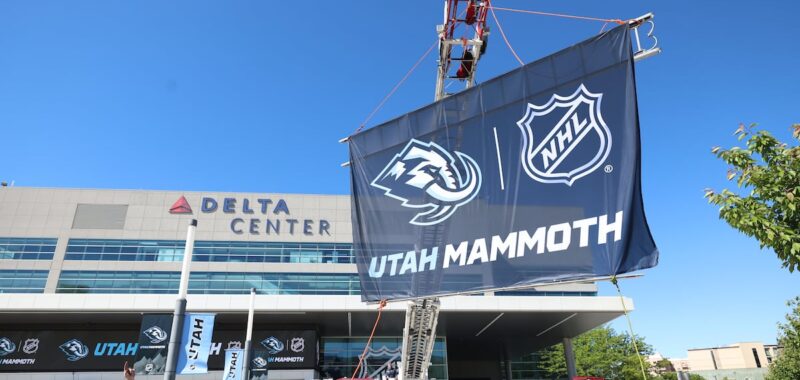As one of Utahâs pro sports teams licks its wounds following poor draft lottery luck, the other is considering trading the lottery pick it received in a feat of never-before-seen chance.
The Utah Mammothâs cupboards are overflowing with top-tier prospects. There wonât be room to sign them all. So, rather than adding yet another 18-year-old who may or may not evolve into an impactful NHL player, why not go after an established young guy who could transition the team into win-now mode?
If thatâs the direction general manager Bill Armstrong decides to go, here are a few options he should consider for the return.
Side note: From a distance, some of these players might not seem available on the trade market. But remember that Mikhail Sergachev was never publicly available until the moment he was traded. Same goes for Mikko Rantanen, Jonathan Huberdeau and a number of others in the last few years.
Anyone can be dealt at the right price, and the fourth-overall pick is a pretty enticing trade chip to get a deal done.
Tage Thompson, Buffalo Sabres
Aside from the ultra superstars, if Utah could steal one player from any team, it would probably be Tage Thompson.
Utahâs prospect pool is full of big guys, but the roster isnât. Thompson is a mammoth of a man â 6-foot-6, 220 pounds. The way he can impose his will on the play often draws comparisons to Mario Lemieux.
He scored 44 goals this year on a Buffalo Sabres team that gave him little support. Heâs currently flanking a World Championship line with Mammoth forwards Clayton Keller and Logan Cooley, where there seems to be some natural chemistry.
At a lot of points last season, Utah seemed one top-six forward away from winning. They lost by one goal 19 times â plus another handful of would-be one-goal losses, were it not for empty-netters. Thompson is a guy that can get you that extra goal when you need it.
Armstrong was the director of amateur scouting for the St. Louis Blues when they drafted Thompson in 2016. Nine years have passed and Armstrong still frequently talks about why that was such a good pick.
Thompsonâs contract is one of the most team-friendly in the league: Just over $7 million for the next four years (coincidentally, the same cap hit as Dylan Guenther). He doesnât have any trade protection until July 1, at which point he gets a five-team no-trade list.
He would fit in well in Utah. Heâd join the long list of guys on the team with young children â he and his wife have two sons and a daughter is due this summer. By all accounts, Utah is a great place to raise a family. Thompson is also a devout Christian â another thing Utah is known for.
It would take a lot to pry Thompson out of the Sabresâ hands, but theyâre not realistically going to win the Stanley Cup before his contract is up. The fourth-overall pick and perhaps another prospect or two might be beneficial for both teams.
Mat Barzal, New York Islanders
The window of competition between Mat Barzal and the New York Islanders is unlikely to match up. Turning 28 this month, Barzal still has plenty of good hockey left in him â but the Islanders are just starting their rebuild.
Like Sergachev the season before he was traded, Barzal suffered two injuries last year. It limited him to just 30 games and posed major mental challenges.
For Sergachev, a fresh start with an increased role was beneficial. Perhaps it would do similar things for Barzal.
Barzal, a right-shot center, has been at or near a point per game most of his career. He could play on either of Utahâs top two lines, which would allow Barrett Hayton to shift into a third-line center role â the spot heâd probably be in on a Cup-contending team.
Acquiring the fourth-overall pick would be particularly beneficial to the Islanders, who already own the first selection. Theyâd be able to select both Matthew Schaefer and Long Island native James Hagens, accelerating their rebuild and giving the fans a reason to buy tickets.
Timo Meier, New Jersey Devils
When Timo Meier was the go-to guy on the San Jose Sharks, he was a point-per-game player. But when he was traded to the deeper New Jersey Devils in 2023, his production dropped off.
In Utah, Meierâs role would be a big one.
Meier is a multi-dimensional player who does a lot of things better than the average player. He makes plays, he can shoot the puck and heâs always in the right place at the right time.
A trade like this would free up some long-term cap space for the Devils, who probably donât love the $8.8 million cap hit attached to Meier for the next five seasons. He has a full no-movement clause, so any trade would have to be approved by him.
Elias Pettersson, Vancouver Canucks
If Canucks management could go back in time, they probably would have traded Elias Pettersson, rather than giving him a long-term, high-dollar deal.
They still have the ability to do so (if Pettersson waives his no-movement clause), but the return wonât be nearly as high as the reported deal they once had in place with the Carolina Hurricanes that would have sent Martin NeÄas, Jesperi Kotkaniemi and additional pieces to the west coast.
Itâs well documented that Pettersson struggles under media pressure â something thatâs abundant in Vancouver. A trade to Utah would cut that pressure out almost completely, allowing him to focus on hockey.
Pettersson is a highly skilled center with silky mitts and an almost unrivaled wrist shot. He plays all special teams and is almost as good defensively as he is offensively.
Is it risky for Utah? Sure. But for a one-time 102-point scorer whoâs still in his mid 20s, the upside could be too good to pass up.

